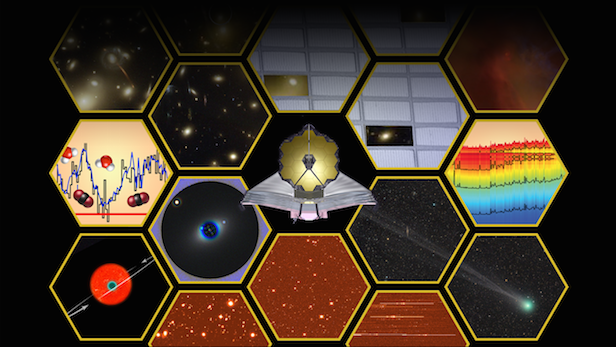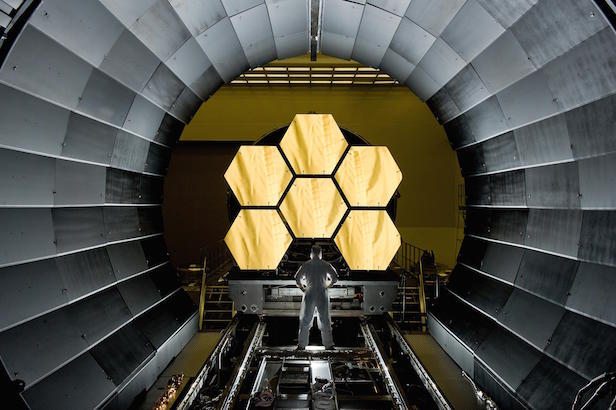Targets pinpointed for NASA’s James Webb Space Telescope
After much consideration, the next-generation instrument will observe 13 targets in its first five months of scientific observations

NASA’s James Webb Space Telescope will have unrivalled capabilities for both imaging and spectroscopically analysing objects in infrared. Image credit: NASA/ ESA/ A. Field (STScl)
The James Webb Space Telescope’s (JWST) targets for initial observation have recently been chosen and include studying Jupiter, planets beyond our Solar System and distant galaxies. After the Space Telescope Science Institute’s call for early results, the JWST will now spend it’s first five months working on 13 science programs, following a six-month commissioning period. The initiative will also include searching for organic molecules around infant stars, studying supermassive black holes and searching the early universe.
“I’m thrilled to see the list of astronomers’ most fascinating targets for the Webb telescope, and extremely eager to see the results. We fully expect to be surprised by what we find,” says Dr. John C. Mather, Senior Project Scientist for the Webb telescope and Senior Astrophysicist at NASA’s Goddard Space Flight Centre, Greenbelt, Maryland.
The results from this observing period will be compiled in the Director’s Discretionary Early Release Science (DD-ERS). This will provide astronomers worldwide with immediate access to the tantalising JWST data in order to swiftly analyse the data and plan future observations.
“We were impressed by the high quality of the proposals received,” says Dr. Ken Sembach, Director of the Space Telescope Science Institute (STScI) in Baltimore, Maryland. “These observing programs not only will generate great science, but also will be a unique resource for demonstrating the investigative capabilities of this extraordinary observatory to the worldwide scientific community.”

The launch for the JWST is now planned to be between March and June of 2019. Image credit: NASA/MSFC/D. Higginbotham
The first 13 science programs were carefully chosen to exercise all four of the space telescope’s science instruments, which will give astronomers the chance to explore JWST’s full light-capturing potential. However, because the telescope has a minimum life expectancy of five years, the scientific community will have to be abrupt in understanding its more advanced capabilities.
“We want the research community to be as scientifically productive as possible, as early as possible, which is why I am so pleased to be able to dedicate nearly 500 hours of director’s discretionary time to these ERS observations,” says Sembach.
An aspect of the innovative space telescope that astronomers can’t wait to utilise is the ability to deeply analyse other worlds orbiting stars outside of our Solar System, known as exoplanets. Starlight from an extrasolar star carries important information about its environment, but when it’s orbiting planet eclipses it, this light is now engrained with information about that planet’s atmosphere. JWST will look to measure this particular information to understand the chemical composition of the planets atmosphere using its infrared spectrographs. Initially, the JWST will be used to study Jupiter-sized exoplanets, such as WASP-39b and WASP-43b, because there are easy targets to test out this technique. From this, observing strategies will become clearer, and the telescope will observe targets that are more Earth-like, in order to search for potential habitability.
Looking further into the universe, the JWST will also examine distant galaxies whose light has been stretched into infrared wavelengths due to the expansion of the universe. NASA’s Hubble Space Telescope has seen many of these galaxies, and galaxy clusters, in it’s time. On the contrary, the JWST has the ability to see these targets in a light undetectable by Hubble. The DD-ERS will look to examine distant galaxies already examined by Hubble in an attempt to provide new and groundbreaking discoveries.
Since August 2017, more than 100 proposals for the DD-ERS were submitted. From this, a series of subject experts and Dr. Sembach had to sift thought the proposals. Thus narrowing down the list to 13 candidates that require 460 hours of telescope time.
For additional information regarding the DD-ERS proposals, please click here.
Keep up to date with the latest reviews in All About Space – available every month for just £4.99. Alternatively you can subscribe here for a fraction of the price!




